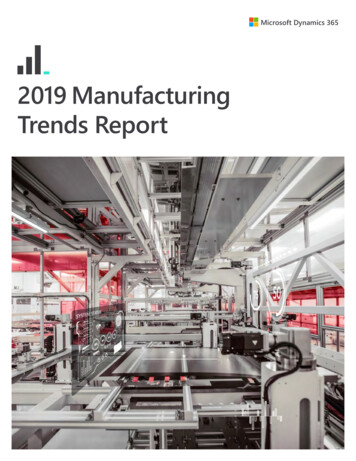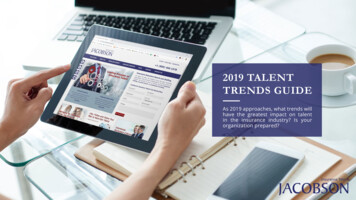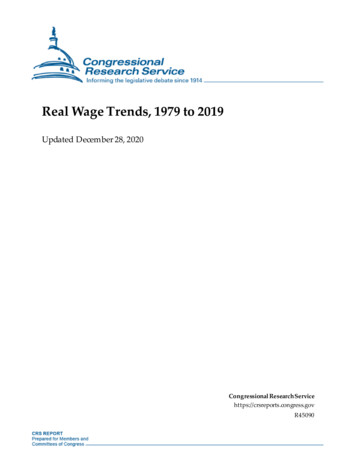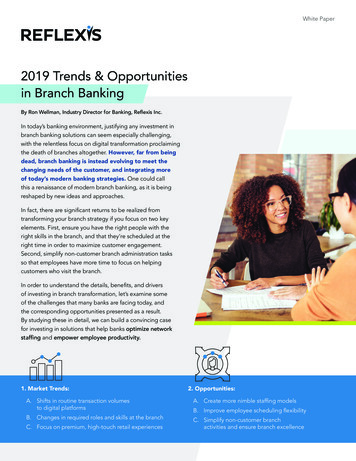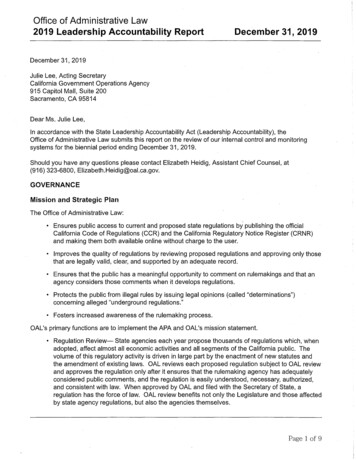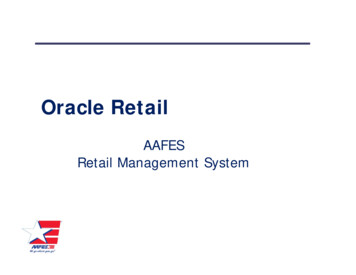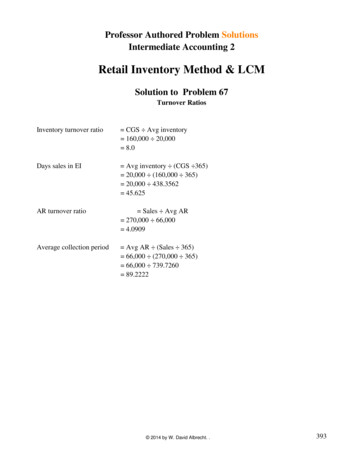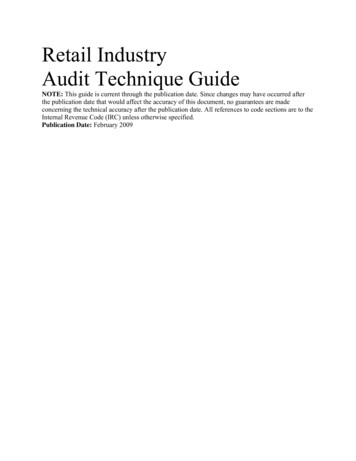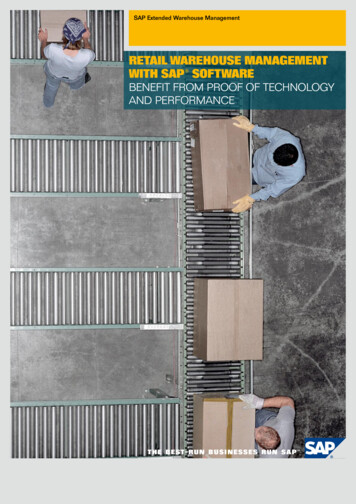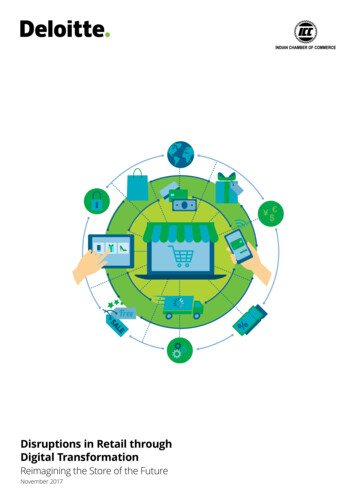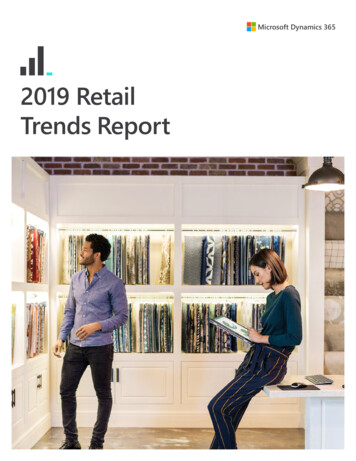
Transcription
Microsoft Dynamics 3652019 RetailTrends ReportPage 1
IntroductionOver the last 15 years, retail has undergone a significanttransformation. The internet has provided customers withaccess to seemingly endless options while mobile technologies have put information at their fingertips, anytime andanywhere.While these changes continue to reshape the retail landscape, we are beginning the transition into the secondphase of this transformation. As the dust of disruption begins to settle, retailers are reinventing their operations tomake them faster, smarter, and more nimble.From fulfillment flexibility to the new x-economies to intelligent automation, retailers are embracing the next generation of retail, one that represents not only a new set oftools and systems but also a new definition and philosophyof retail.The following will explore six emerging trends in retail thatwe believe will help empower retailers to create exceptional,insightful shopping experiences for their customers.Page 2
Trends4Customer experience is everythingEmpowered customers expect amazing experiences12The changing face of retailThe retail business model is evolving21The everywhere storeCustomer can purchase from anywhere26Operations drive excellenceMeeting customer demands requires optimized operations32Next-gen technology makes an appearanceNew technologies are revolutionizing retail38Living in the age of uncertaintyUncertainty puts strain on businessesPage 3
Customer experienceis everything Innovation raises customer expectationsMillennials evolveGen Z gains influencePersonalization as the ruleRetail becomes a serviceRetailers bridge the digital dividePage 4
Customer experienceis everythingInnovation raises customer expectationsStating that technology is changing customer demands feels like stating theobvious. Innovation—from the printing press and combustion engine to computers and wireless internet —has always been a driver of demand, unlockingnew possibilities and raising expectations. Today, we find ourselves at the intersection of rapid innovation and a new generation of consumers who havegrown up empowered by technology.Millennials evolveThe number and influence of Millennials continue to grow. Today, Millennialsmake up roughly a quarter of the U.S. population,1 and according to the PewResearch Center, they will overtake Baby Boomers as America’s largest population in 2019 (73 million vs. 72 million).2 On the surface, Millennials look verydifferent from their predecessors: they are more diverse,3 better educated, andmore likely to be never married than any other adult generation was at thesame age.4They are also a generation who entered adulthood facing a strong headwind.They have been crippled by student loans, with over 60% of students takingout loans to pay for college.5 The average student loan debt for Millennialsgraduating in 2017 was nearly 40,000.6 To compound this, many graduated inthe midst of the 2008 recession. As a result, they have been pressured to takelower paying jobs and have lower employment rates compared to workers ofthe same age in past generations.7However, despite these challenges, Millennials are smart and savvy. They havebecome a generation that is fiscally responsible, with 63% of Millennials setting savings goals and 59% reporting feeling financially secure, higher ratesthan Boomers or Gen X.8 Seventy-three percent of Millennials stick to theirbudgets every month, and 16% have saved over 100,000.9Page 5Executive summaryCustomers don’t just want seamlessexperiences across their devices; theyexpect personalized, experiential andmobile-first shopping interactions.Highlights Millennials make up roughly aquarter of the U.S. populationand will overtake Baby Boomersas America’s largest population in2019 (73 million vs. 72 million). 0.56 of every dollar is influencedby a digital interaction.The average studentloan debt forMillennials graduatingin 2017 was nearly 40,000.
Parents who said their GenZ children influence theirbuying decisions.By 2020, Gen Z will be the third-largest generation in the U.S., just behindGen X, and they are already accumulating significant purchasing power.With their oldest members only intheir early twenties, it is difficult toThe profile of Gen Z is lengthy, andwe have much to discover aboutthem as they mature. But for now,one thing is sure: Gen Z will have asignificant impact on both businessand the world.Page 612 24 16H212 %4%Greatest/SilentBoomersGen XMillennialsGen Z4%70 30 J70%Like Millennials, Gen Z is made upof savvy shoppers. According to arecent report by Interactions, 89%of Gen Z considers themselvesprice-conscious shoppers and listedprice as the top factor in making apurchase.16 According to the report,72% said they would switch fromtheir favorite brand if they founda similar product at a lower price.Members of Gen Z also value community, with 59% preferring localstores over large retailers and 72%saying they would be more willingto shop at national chains if theyhad more of a local presence in theircommunity.Population by generation24 %As the size and influence of the Millennial cohort grow, they are proving themselves to be a generationof tech-savvy individuals. But whereMillennials were digital pioneers,helping make technology mainstream, Gen Z is the first generationof digital nativists, never having experienced life before computers andpervasive internet.Gen Z is even more diverse than theirMillennial predecessors and will become the nation’s first majority nonwhite generation. With this diversitycomes a much more tolerant andinclusive generation.14 Additionally,growing up with the internet gavethem much greater visibility intoglobal issues. As a result, they area very globally and socially minded population. Twenty-six percentof 16-to-19-year-olds currently volunteer, and 60% reported that theywant their jobs to impact the world.15By 2020, Gen Z willbe the third largestgeneration in the U.S.2Gen Z gains influencepredict Gen Z’s purchasing behaviors precisely, but what’s clear is thatthey already wield great spendinginfluence. There was 829.5 billionspent on Gen Z in 2015, accountingfor 6.8% of total consumer spendingthat year.12 Furthermore, over 70%of parents said their Gen Z childreninfluenced their buying decisions onclothes and food.1316%While their financial burdens have ledto lower rates of home and auto ownership,10 Millennials do spend in other areas; however, they remain thriftywhen they do. Case in point: Amazon accounts for the largest volumeof online apparel sales for Millennials, nearly 17%, more than doublethat of the next largest seller, Nordstrom.11 This shift to thrift has alsoplayed a role in the growth of on-demand services, sharing marketplaces, and online consignment stores.
a 00 38362529201113585242333226241421650 Build greater customer loyaltyTarget new customers with more effective digital campaignsIncrease customer satisfactionIncrease order values (e.g., cross-sell/up-sell)Reduce customer churn with more effective experiencesIncrease conversation ratesReduce marketer effort in personalizationIncrease relevancy of the brand experience; increase brand relevancyPrimary goals ofpersonalizationPrimary goalSecondary goalTertiary goalPersonalization asthe ruleFrom ecommerce to mobile checkout, technology is infusing the retailexperience. Greater connectivity todevices has created better-informedconsumers who have the ability tonot only research products and shoponline, but also to compare competitors’ product prices and availabilitywhile in store. It is changing the waycustomers research products andmake a purchase, and increasingly, it is changing the way customersinteract and build relationships withbrands.As ecommerce leads to greatercommoditization, many of today’scustomers are seeking a greaterconnection to their brands, a morecurated shopping experience thatfeels genuine and unique to them.This type of personalization requirescapitalizing on available technologyto understand customers’ preferences, providing them with exactly whatthey want, when they want it, in theway they want to receive it.Leveraging new technologies—likerecommendation engines poweredby artificial intelligence and machinelearning—retailers can make moreindividualized product suggestionsthat ultimately translate into sales.These engines utilize previouslycollected user information (such aspast purchases and items clicked onbut not purchased) to provide tailored recommendations and offers.According to a Boston ConsultingGroup research study, brands thatcreate personalized experiences byintegrating advanced digital technologies and proprietary data forcustomers are seeing revenue increase by 6% to 10%—two to threetimes faster than those that do not.17As customers become more comfortable sharing personal information and preferences in exchange forpersonalized rewards—nearly half ofconsumers surveyed in 2016 no longer had concerns about online privacy18—retailers are putting data towork by tying their customers’ digital-channel behavior to the in-storeexperience, welcoming shoppers byname and making suggestions basedon purchase history.Another way to gain customer loyalty in a highly competitive market isusing data to inform your rewardsprograms and send targeted offers based on previous purchases, amodel Walgreens has leveraged fortheir Balance Rewards program.19Beyond personalized messaging andrecommendations, innovations inPage 7Brands that createpersonalized experiences byintegrating advanced digitaltechnologies and proprietarydata for customers are seeingrevenue increase by 6% to10%—two to three timesfaster than those that do not.
manufacturing have led retailers toexperiment with a new way to differentiate their products: allowingcustomers to develop personalizedproducts. Nike’s NIKEiD programhas led the product-personalizationcharge, allowing customers to createa completely custom shoe or athleticbag that arrives in four to six weeks.To achieve this, Nike partnered withmanufacturers to automate factoryprocesses and develop laser technology that streamlines the productionprocess.20Other retailers take advantage of online buying to offer customizationoptions for products that previouslyrequired in-store measurements ortailoring. On the websites of menswear companies Indochino, BlackLapel, and Knot Standard, men canselect their desired fit and cut andthen upload their measurements fora “bespoke” suit.Taking it one step farther, somebrick-and-mortar stores have beguntesting 3D-printing and 3D-knittingstations, essentially offering on-demand personalization. Lowe’s haspiloted a six-month project, dubbedBespoke Designs, that allowed customers to repair broken parts, replicate a beloved object, or create custom hardware at in-store 3D-printingstations.21 Adidas and business-wearcompany Ministry of Supply bothoffer customers the opportunity tocraft their own cardigans and sweat-ers with the assistance of a 3D-knitting machine.22 At the Adidas pop-upshop in Berlin, customers can complete a 3D-body scan and choose thecolor and design of a merino sweater,which will be knitted, washed, dried,and ready to take home in underfour hours.A personalized shopping experienceincreasingly includes the checkoutexperience as well. Customers wantmore control over their delivery andpick-up options. The expansion ofshipping programs that offer freedelivery have decreased customers’willingness to pay for shipping; 70%of consumers will choose the cheapest delivery option. More retailersare now offering customers greaterflexibility in how they order and pickup their item, whether in a store or atan alternate pick-up location, such asan Amazon Locker or a UPS AccessPoint.Companies are even pioneering other creative delivery-channel solutions to provide customers withgreater flexibility. For example, DHLhas partnered with Audi to deliverpackages to customers’ trunks viaAudi’s keyless entry system.23 By optimizing digital inventory supply andthe location of distribution centers,retailers will be better prepared topersonalize delivery-channel methods, including fulfilling same-dayshipments.Page 8Innovations inmanufacturing have ledretailers to experimentwith a new way todifferentiate theirproducts
Retail becomes aserviceOnline sales continue to outpace industry growth by 300%24 making itessential that retailers seek out opportunities to generate excitementin brick-and-mortar locations. Onlineshopping has changed the traditional paths to purchase: 43% of customers who browsed for a productonline also bought that product online.25 Two practices, “showrooming”(viewing/trying products in-storebefore buying the same product online at a lower price) and its inverse,“webrooming” (browsing productsonline before buying in-store), doimpact the way customers make purchase decisions.26 However, customers ultimately are browsing and buying in stores at the same rate theyare showrooming and webroomingcombined.Fully engaged customers—thosewho are emotionally invested in abrand and loyal to it—visit retailersmore frequently and spend moremoney per visit. For example, Gallup data shows that, on a given visit,fully engaged consumer-electronicscustomers spend nearly 100 morethan actively disengaged customers (those who will readily switchbrands).27In order to engage customers, retailers across all industries are buildingservices and events into their busi-ness models. According to CEI Research, 86% of customers will paymore for a better customer experience, and customers who are engaged with an experience are lesslikely to think about product cost.28Apple has been at the forefront ofexperiential retail with its in-storetech support, the Genius Bar, andhands-on product displays. But eventhe pioneer has recognized the needto constantly evolve its in-store offerings, launching Today at Apple:free, interactive programming on avariety of topics, such as music, photography, and coding.29 Cosmeticscompan
Target new customers with more effective digital campaigns Increase customer satisfaction Increase order values (e.g., cross-sell/up-sell) Reduce customer churn with more effective experiences Increase conversation rates Reduce marketer effort in personalization Increase relevancy of the brand experience; increase brand relevancy Primary goals of personalization Primary goal Secondary goal .
